Out West or Bust
Sometime in the early '70s I got a copy of Zofia Kielan-Jaworowska’s superb account of the Polish expeditions to Mongolia in the 1960s, Hunting For Dinosaurs. Just how the still recovering from the devastating horrors of WWII Poles ended up all the way over in Mongolia digging up dinosaurs I have never fully understood, but in any case the book motivated a generation of dinophiles to heroically venture into remote badlands and brave the ruthless elements at great personal discomfort to rescue from the inexorable forces of erosion many a magnificent dinosaur skeleton for the edification of the public and the extension of scientific knowledge. I got my opportunity to do so early in 1978 when Bob asked if I would like to join his expedition out west in the summer. Of course I would. It involved nearly three months of assorted adventures looking for fossils in the brutal heat of the Paleogene beds of Kutz Canyon in New Mexico (where Bob’s hero Edward Drinker Cope once worked), the Cretaceous North Horn in the mountains of Utah (near where my grandmother grew up; in a brief stopover in Salt Lake I saw my declining great aunt Laurel the last time), and the high plains of Wyoming at Como Bluff (just a lovely location), and the Pierre Shales (started to get heat exhaustion there one day) that Ken Carpenter was working. The main project at Como was excavating part of the skeleton of a very large Jurassic sauropod of possible titanosaur affinities that has never been described. Also spent considerable time in Boulder, Colorado. Not a bad place to be stuck in for a few weeks (due to the abject failure of Bob’s van as we approached the Kansas border on I-70, and then being towed all the way back to Boulder where they could fix VWs). While there the first big dinosaur story of the Dino Revolution hit the national news: Jack Horner, then at Princeton, had discovered hadrosaur nests in his native Montana!
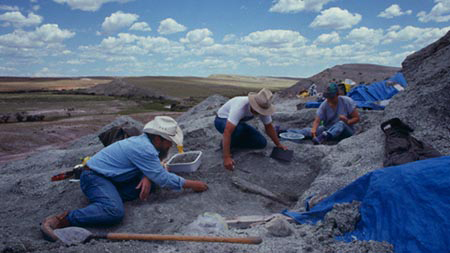
I also went out with the Johns Hopkins crew in 1979 and '80, those expeditions mainly focused on the Eocene sediments in the Bighorn Basin of Wyoming. Not much dinosaur stuff but lots of archaic mammal teeth set on jaw fragments. The often mercurial Dr. Bob proved skilled at vexing his crews, which consisted of a mix of undergrads and grads. He almost died at one point by the way. The crew went out ahead of Bakker in 1980, to southeast Wyoming amidst a Minutemen III ICBM field near beautiful downtown Torrington. We thought the missile silos were some sort of gas works until the locals informed us otherwise.
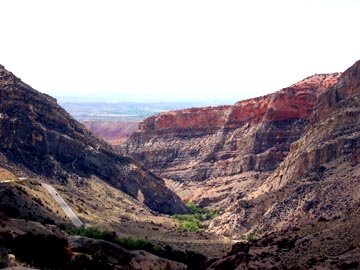 We were working an early Cenozoic fossil bird bed, why I do not know. When Bakker arrived in his van he was already acting a little odder than usual. Next day he was worse, and seemed to be having serious mental issues. I was told he would approach fences he wanted to cross and then back off, approach again and so forth. By the third day or so it was obvious he was in very serious trouble, but Bob refused to go to the town’s hospital, he just wanted to go to a motel. A story was invented about the gang wanting to go swimming in the river by Torrington, and he went along with it. Eventually the grad students got him to the hospital where the staff had to put him on ice to bring down the getting-to-be lethal fever. Because it was a Saturday they could not do the proper tests, it turned out to be Rocky Mountain spotted fever he picked up traveling west.
We were working an early Cenozoic fossil bird bed, why I do not know. When Bakker arrived in his van he was already acting a little odder than usual. Next day he was worse, and seemed to be having serious mental issues. I was told he would approach fences he wanted to cross and then back off, approach again and so forth. By the third day or so it was obvious he was in very serious trouble, but Bob refused to go to the town’s hospital, he just wanted to go to a motel. A story was invented about the gang wanting to go swimming in the river by Torrington, and he went along with it. Eventually the grad students got him to the hospital where the staff had to put him on ice to bring down the getting-to-be lethal fever. Because it was a Saturday they could not do the proper tests, it turned out to be Rocky Mountain spotted fever he picked up traveling west.
The prior year we worked for some weeks near a badland county reservoir about the size of a postage stamp. On the first weekend we were astonished to see the locals actually water skiing on the darn thing - it was all they had. Next year as we drove atop the dam such as it was I offhandedly told novice fossil hunter Mary Copeland about the coming weekend water sports as a point of interest. She turned on me, outraged that I would tell her such a silly story and think she was dumb enough to believe it. I decided not to argue. That Saturday as we rode over the crest of the ridge to see the ranchers et al. circling around in their boats with skiers in tow I enjoyed seeing the look on Mary’s face. Or at least that’s the dramatic way I remember it. An alternative memory is that I was in camp when Mary returned from a weekend trip past the reservoir and asked her about the skiers to which she refused to reply. Either way it was satisfying.
As much as I loved the western landscapes and enjoyed much of the field work – it can be exciting and evocative revealing dinosaurs bones that have been buried 65+ million years, I found out some truths. For one thing, it is usually really hot. Yes it's dry heat, but it’s still bloody hot. And to rub it in there were often white capped mountains in the distance tempting us with their cool, conifer scented slopes and icy streams. And the bugs. For heavens sakes, the bugs. A tip on entertaining yourself while stuck in the tent during the daily attack of the mosquitoes: place the tip of your finger near one of the many mosquitoes on the screen and watch it probe inwards trying to get to your blood. Did I mention the giant pale white centipede that caused the riders in the Chevy suburban to hastily abandon ship from the thought of the thing crawling up one of our legs as we arrived back at the Angel Peak campsite in '79? Actually it was pretty fun disassembling the inside of the vehicle to track the thing down. Also amusing was the scorpion that dropped out from my jeans as I put them on one morning in the Bighorn basin (so do not leave your tent screen open when helping those whose tents blew down in the storm).
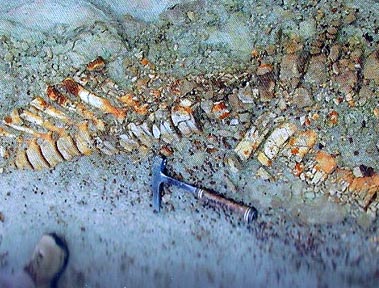
Dreams of months spent in really isolated lands faded, I preferred locales where root beer floats and pizza were available in the closest town. While Bob and Ken remained in the field to uncover yet more fossils, I joined the rest of the crew in their side trips to Yellowstone, etc. The best locale in this sense I have worked at is Garden Park where we used the BLM showers and other facilities every day after work, and the locales provided great food. Therefore, although I occasionally dabble, field work is not my forté.
Rigors of the Field
It being obvious I was going to do the dinosaur thing, I quit Dart Drug (where I rose to head cashier under the wing of the one competent manager before downgrading to part time work), as I got commissions and other paleowork, and moved to Baltimore after the '79 expedition to study informally under Bakker. This was when his clique was still getting along.
In '78 attended my first Society of Vertebrate Paleontology meeting, an annual fall affair, that year in Toronto. Along for the ride with Mike and I, was Indian paleontologist Sankar Chatterjee, then at the Smithsonian. There was just one technical session over the three days. Mainly fish and mammals. I shall list every one of the dinosaur presentations that year, in order of appearance.
Bakker, Robert T. Speed in dinosaurs and other extinct land vertebrates.
Horner, John R. Cranial kinesis in some hadrosaurian dinosaurs.
Galton, Peter M. Skeleton of ornithopod dinosaur Camptosaurus from Upper Jurassic of England.
Dodson, Peter. Comparative osteology of the ornithopod dinosaurs Camptosaurus and Tenontosaurus.
Johnston, Paul A. Growth rings in dinosaur teeth. (An early and errant attempt to refute the dinosaur endothermy hypothesis.)
Tyson, Helen. Structure and function of the frill of ceratopsian dinosaurs.
That was about it, although Kevin Padian gave a presentation on pterosaur flight. The banquet was in a modest sized room in the Royal Ontario Museum. I have since attended most SVPs, which have grown in scale until listening to all the dinotalks and seeing all the dino posters is rather exhausting (they can number around 130[!] at a given meeting - yet mammals still predominate). Ken Carpenter who was deeply involved in the meeting in the olden days has stopped going, finding the 21st century megaconclaves too impersonal. But they are always chock full of new data.
In the late '70s and continuing into the early '80s, Bakker and I, often accompanied by Ken on his visits east, would make trips up to Princeton to hang out with the ex-Marine Vietnam vet Horner who was biding his time until he could scoot back to Montana, the American Museum, and on to Yale where Ostrom ruled the roost. On one trip in April was stunned when an unpredicted winter storm with until then unprecedented in my experience thunder dumped so much snow on Princeton that we had to abort the rest of the trip northeast.

During those years I was taken under the wing as it were of an editor at Smithsonian Press. That led to some commissions for Thread of Life (which also included a rare set of all the Matternes Smithsonian murals, albeit improperly cropped at the sides). At Hopkins, evolutionary scientist Steven Stanley commissioned work for his Earth and Life Through Time. Kindly, grandfatherly Donald (Mr. Trackway) Baird at Princeton hooked me up with the folks at Richard Rush Studios in Chicago. They needed help designing a full-size sculpture of Dilophosaurus for a new trackway exhibit in Connecticut. I was both happy and nervous about the job. Nervous because I was concerned that the studio’s sculptor, Roger Walshlager, would botch his end of the project. Artists often panic when dealing with dinosaurs, producing stereotypical pseudo-animals than the realistic wildlife they really were. When I flew to Chicago to check out his preliminary small scale model I was delighted with the excellent result. You can see the final model at Rocky State Park.
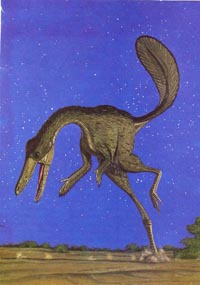 Ever since the early '80s I have applied feathers to many of the small dinosaurs, and never did smaller theropods without them. I did so because birds evolved from small theropods, and the evidence for the latter having the high metabolic rates that would have promoted the evolution of insulation was solid. I used to receive endless grief for this. The counter-argument was that no feathers had been found on any dinosaurs, and scales had, so I was engaging in unfounded speculation. But these points were actually not scientific. Scales had been discovered only on large dinosaurs, so illustrating small ones with scales was no less speculative than putting feathers on them. It would be like illustrating little mammals with naked skin if all we had was elephants and rhinos to base mammal integument on. I knew that my thesis was logical, so I bided my time.
Ever since the early '80s I have applied feathers to many of the small dinosaurs, and never did smaller theropods without them. I did so because birds evolved from small theropods, and the evidence for the latter having the high metabolic rates that would have promoted the evolution of insulation was solid. I used to receive endless grief for this. The counter-argument was that no feathers had been found on any dinosaurs, and scales had, so I was engaging in unfounded speculation. But these points were actually not scientific. Scales had been discovered only on large dinosaurs, so illustrating small ones with scales was no less speculative than putting feathers on them. It would be like illustrating little mammals with naked skin if all we had was elephants and rhinos to base mammal integument on. I knew that my thesis was logical, so I bided my time.
Unlike life restorations which I date on completion and even upon a major revision, I do not do so with the skeletons (I slice and dice the tracing paper originals and the smaller master copies so much that it is not really practical). So I think it was 1980 when I began to more systematically and meticulously restore dinosaur skeletons, sometimes in multiple views (I do at least one for a given group when it is practical).
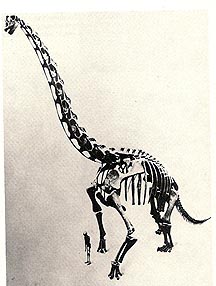
One reason I was not a Burian fan was because he believed that a true artist did not start with a detailed skeletal study, that art was supposed to be free hand (I was told this by an associate; Zallinger seems to have been of the same school, and Knight did not produce careful preliminary studies although he was a superior, intuitive anatomist). This is contrary to the long tradition by fine artists of studying animals and human anatomy. I was finding that previous skeleton restorations by other illustrators were almost always seriously flawed in basic proportions, Dale Russell’s being a notable exception.

So I have never since trusted another researcher’s work ad hoc. Started my more rigorous series with tyrannosaurs, probably Daspletosaurus first, in order to do something about correcting the painting of the same, followed by Tyrannosaurus. Spent considerable effort on my beloved Brachiosaurus/Giraffatitan that until then was illustrated only with an inaccurate sketch of the skeleton. It proved a more elegant form than I thought. The skeletal work obsolesced much of my previous life work based on the sketchier skeletal reconstructions, forcing the series of upgrades that continues today. That’s science. My long-term goal has been to restore the adult skeleton of every dinosaur species for which one can be done, a target that can never be fully achieved because of the remarkable rapidity with which dinosaurs are now being found and published, but I am reasonably close to the goal. I derive great enjoyment from executing a new skeletal reconstruction, it is a pleasing technical process that gives me a better idea of the form of yet another dinosaur taxon. Some species are done in multiple views, including the top, and sometimes front and back views. I then use the skeletal plan to build a quick and temporary plasticine model, and from that approximate the mass of the specimen (if the skeleton is in side view only, and is very similar to that of close relatives, I may instead calculate volume via comparative overlays). I still prefer penciling the skeletals on large sheet tracing paper rather than going digital, in part because I get a nice impression of the size of the sauropods at around 1/20 scale. The standard poses I adopted to ease preparation and facilitate cross comparison of the large number of restorations were sufficiently dramatic and appealing that they have become iconic, with some skeletons being mounted in their style. The white on black style I did not invent but that I popularized has also become common for restoring prehistoric animals.
While doing some of my first high fidelity ornithischian skeletal restorations I ran into a problem. Supposedly, birds hold their femora horizontal and nearly immobile while walking and running – although why they would do so while running never did make much sense since that just wastes a limb segment. The problem is that the non-armored ornithischians, including the giant iguanodonts, hadrosaurs and ceratopsians, have the same basic hip joint anatomy as birds, with a big antitrochantor at the back of the hip socket bracing the head of the femur. Ergo, the ornithischians should have horizontal femora too. That definitely did not make sense. A horizontal femur might work in a bird with a very long lower leg, but the dinosaurs have much shorter legs below the knee and the femur had to be an important part of limb action. In 1981 I learned that NOVA was going to broadcast a program titled Animal Olympians. It was my dream that they would include film of a running ostrich so I could get a better idea of its limb action. As the show went along they showed a human sprinter, and started talking about bipedal runners. Please, please, I thought, show a running ostrich. Please. The next scene was film of a barren flatland taken from a speeding vehicle. All that could be seen were puffs of dust being kicked up by some two-legged animal running to the right of the screen. Gradually the vehicle caught up to reveal an ostrich going full tilt, its arm feathers held clear of the knees which I could see were working back and forth almost as much as a mammals. Problem solved. Even though treadmill running ostriches do the same thing, some biologists still think bird femora are nearly immobile.
By the late 1970s I was discovering that I enjoyed scientifically researching dinosaurs at least as much as illustrating them. So my goals shifted from being a Matternes/Knight-style artist doing the bidding of the scientists to being a combo scientist/illustrator who would figure out how to do the restorations myself; most paleos not being sufficiently competent to guide artists in the arcane field anyway.
This would be synergistic in that not only would the science influence the art, the reverse would be true as well. This is literally true. When I eventually got around to restoring the skeleton of the well-known Camarasaurus in accordance with my rigorous methodology, I found that what was typically thought of as a conventional sauropod with level back was actually a little shoulder high, and confirmed that it had a retroverted pelvis that may have allowed it to slowly walk on two legs, perhaps while browsing. Skeletal restorations of Coelophysis and Syntarsus helped show they are actually the same genus, a synonymy accepted by Ghost Ranch Coelophysis expert Alex (Bigfoot) Downs (who started out prepping a GR block at the Smithsonian) as well as the describer of Syntarsus.
In 1978 I made my first stab at technical research. Folks had long wondered how the sauropods fed their colossal bodies with such small heads even as low energy reptiles. Those opposed to energetic dinosaurs cited the inability of sauropods to stoke a mammalian food budget as evidence they had reptilian power levels. The idea was that if sauropods had food requirements like big mammals they should have large heads like big mammals. The problem with that concept was obvious, the biggest birds, the ratites, have small heads yet are able to feed high metabolic rates. So I did the obvious science. I measured the width of the mouths in herbivorous birds and mammals and plotted it as a function of body mass (ran the regressions on one of the new minicomputers). Did the same for sauropods. Turned out that sauropod mouths were as broad as those of ratites and ungulates. Did a short paper for Nature which Bakker was confident would be accepted. The reviewers dismissed it as yet another attempt by one of those dinoendothermy people, denouncing such efforts to demonstrate physiology in extinct animals as futile – this when the paper was showing that mouth size could not be used to determine metabolic rate. It was a lesson that peer review is not the rigorous and objective system it is supposed to be, reviewers are often dolts with an agenda. Due to a series of publishing misadventures including a symposium volume that never came out, an updated version of the analysis would not be published until twenty years later, just a year before Per Christiansen independently used the same method to arrive at similar results. Whew, that was close. Nowadays most researchers agree that sauropods had elevated food budgets. For that matter the modern majority view has come around to agreeing that the fast growing, highly active dinosaurs were more like birds and mammals than reptiles in their thermophysiology.

It was while defending the hypothesis that birds are dinosaurs against the flawed counter arguments that our feathered friends are the relations of crocodilians or archaic thecodonts, that got me wondering how it actually went down circa 1980. Something was not right with the standard scenario. The latter was a simplistic, progressive evolutionary affair in which bird-like dinosaurs began to evolve short wings, leading to Archaeopteryx and then more advanced birds. But the dromaeosaurs, troodonts, oviraptors and so forth appeared after Archaeopteryx. That was a little odd. Even odder was that looking at field photos of the famed fighting Velociraptor caught in its death throes with Protoceratops, I could see what looked like uncinate processes on the ribs, and a large sternal plate attached to the ribs via ossified sternal ribs. These are avian features retained in most flightless birds but not found in Archaeopteryx. In the fall of 1981 I made a trip to London primarily to see its Archaeopteryx, Bavaria to investigate the Eichstatt specimen which revealed that its skull was much less bird-like than widely thought, then to a paleoconference near Warsaw, and finally East Berlin to check out its Archaeopteryx specimen and most of all, the great Brachiosaurus.
While at the Humboldt Museum a fellow American asked curator Hermann Jaeger what he thought about living in a communist state. At first thinking that this likely to be one of those awkward moments, I was amazed as Jaeger delivered a long lecture denouncing the tribulations of living like a prisoner in East Germany. This guy did not appear to worry or care about his office being bugged. My flight home was out of West Berlin so I had to go through the notorious Checkpoint Charlie before it was officially opened in the morning.
Back in Poland the Solidarity movement was underway, and one evening a member from Gdansk visited a colleagues apartment to tell about what was going on with the anti-communist movement – all in Polish to my vexation. More pertinent to this discourse, Halszka Olmolska showed photographs of the fully prepared fighting Velociraptor confirming the presence of the ossified sternum, ribs and uncinates. In addition, dromaeosaurs had those ossified rod stiffened pterosaur-like tails that appeared adapted for flight. Also the folding arms useful for tucking wings up out of the way. And wouldn’t it make evolutionary sense that primitive fliers would be prone to losing flight on a regular basis, being able to easily reconvert the clawed finger hands to non-flight uses? The conventional view that once birds began to fly they refused to give it up until much later when losing flight was harder to do is evolutionarily naive, being the sort of automatic progressivism that researchers are warned against postulating. My conclusion was that the sickle clawed deinonychosaurs and oviraptors were secondarily flightless dinosaurs that descended from fliers more aerodynamically advanced and phylogenetically closer to modern birds than Archaeopteryx. I proposed the thesis in a little paper in the Third Symposium on Mesozoic Terrestrial Ecosystems volume in 1984, my first technical paper. Otherwise I awaited further fossil evidence on the issue.

I also was perplexed as to why the strange therizinosaurs, the ground sloths of the Cretaceous, were being classified as theropods when they had the fully developed inner toe lost in the theropod-bird clade way back in the Triassic. And the one good skull had prosauropod and ornithischian features. So I submitted a paper to the then young Journal of Vertebrate Paleontology proposing that they were a late surviving link between the herbivorous dinosaurs, which was published towards the end of 1984. The only problem with my second published paper is that more detailed examination of therizinosaurs later showed they were advanced theropods after all. Oops. (Next)

